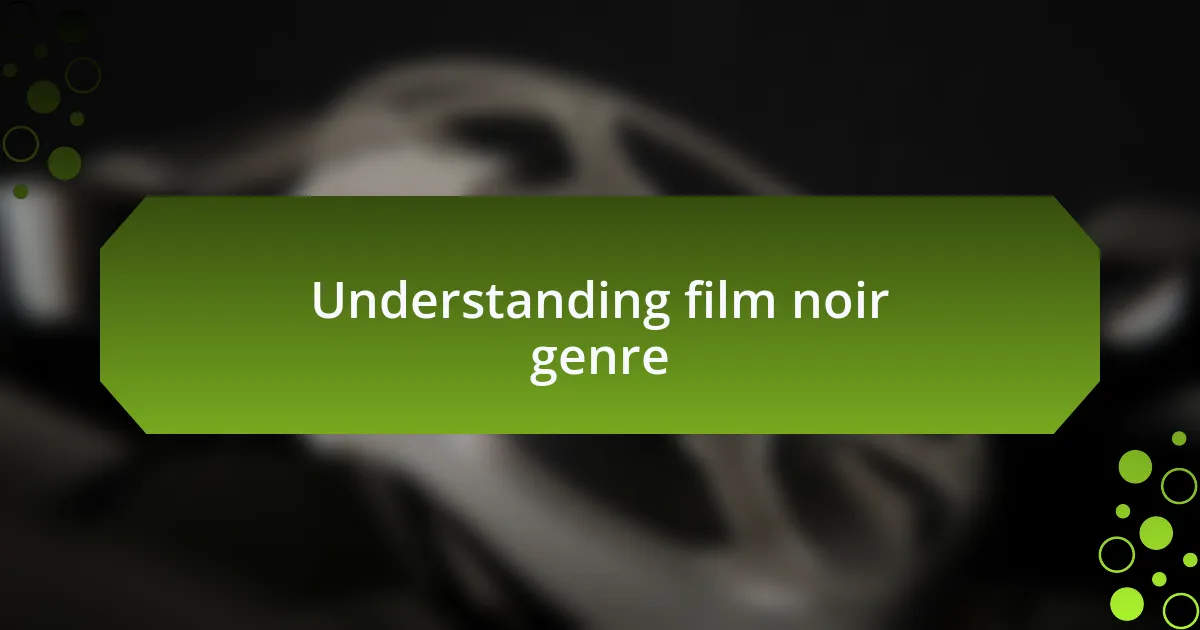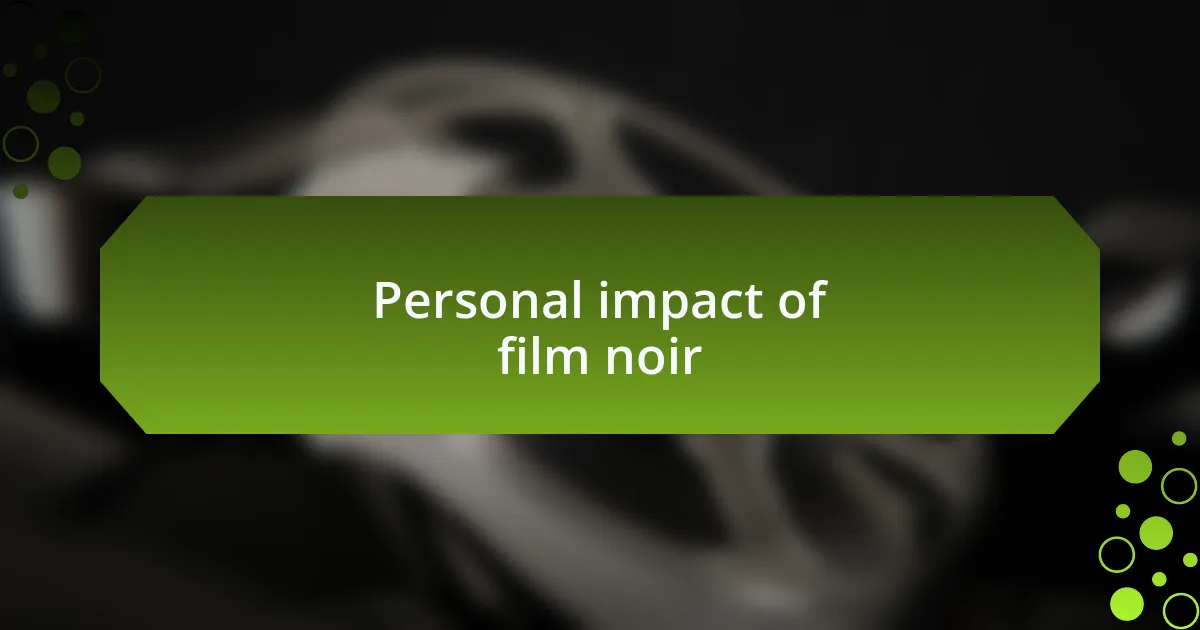Key takeaways:
- Film noir, originating in the 1940s, is marked by its dark themes, visually striking aesthetics, and complex characters that often embody moral ambiguity.
- Streaming services have made film noir more accessible, allowing viewers to explore a diverse array of titles and interpretations while enhancing their understanding of the genre.
- Classic films like “Double Indemnity,” “The Maltese Falcon,” and “Chinatown” are highlighted for their engaging narratives and strong thematic resonance.
- The personal impact of film noir extends beyond entertainment, influencing creative pursuits and encouraging reflection on complex human emotions and societal roles.

Understanding film noir genre
Film noir is a fascinating genre that emerged in the 1940s, defined by its dark themes and visual style. I remember the first time I watched “Double Indemnity,” feeling enveloped by the heavy shadows and morally ambiguous characters. It made me question the choices we all make and how they often lead us down a murky path.
At its core, film noir deals with the complexity of human nature. When I first encountered the femme fatale trope in classic films, it struck me how these characters aren’t just villains; they often reflect deeper societal fears and desires. Isn’t it intriguing how a single character can embody both allure and danger, challenging our perceptions of morality?
The visual aesthetic of film noir is equally compelling. The interplay of light and shadow creates a claustrophobic atmosphere that mirrors the psychological tension experienced by the characters. Watching these films, I often found myself entranced by how cinematography tells a story of its own, leaving me to ponder the hidden meanings behind every frame. Could it be that the shadows represent our inner doubts and fears?

Importance of movie streaming
Streaming services have revolutionized how we access films, allowing us to dive into the immersive world of film noir anytime. I still recall the first time I selected “The Maltese Falcon” from a streaming platform; it was a moment of pure excitement. Being able to watch classic noir films with just a few clicks has made exploring this genre feel like a treasure hunt, revealing hidden gems I never would have encountered otherwise.
The convenience of streaming brings film noir directly into our homes, fostering a deeper connection with the genre. I find myself able to binge-watch a collection of titles that explore similar themes—like moral ambiguity and betrayal—without the hassle of searching for DVDs or relying on television schedules. It’s a game-changer that not only saves time but enriches my understanding of the genre’s evolution.
Moreover, streaming opens the door to diverse interpretations of film noir from different cultures, expanding our appreciation for the genre. I recently stumbled upon a neo-noir film from Japan that offered a unique perspective, blending traditional noir elements with contemporary issues. Isn’t it fascinating how technology broadens our horizons and allows us to engage with cinema in such a meaningful and personal way?

Popular platforms for movie streaming
When it comes to popular platforms for movie streaming, Netflix stands out as a go-to for many film enthusiasts. I vividly remember the first time I discovered their extensive collection of film noir. It was like stumbling into an all-night diner, where every booth holds a classic—each film just waiting to be devoured. The thrill of exploring their library to find something obscure yet brilliant is something I cherish.
Then there’s Amazon Prime Video, which offers a unique blend of mainstream and indie titles. I once spent a rainy afternoon sifting through their curated lists, coming across a little-known noir film that completely blew me away. The ease of renting or buying films that aren’t available for streaming elsewhere is a significant perk. Does it not feel satisfying when you uncover a hidden gem that feels like it’s just for you?
Hulu, while often associated with current TV shows, also boasts an impressive selection of classic films, including some timeless noir favorites. I find myself diving into their collection when I want something that resonates with the grit and realism of post-war America. It’s interesting how a platform initially known for episodic content can also serve as a treasure trove for those of us who appreciate the depth of noir storytelling.

Exploring classic film noir films
Classic film noir is a captivating genre that immerses viewers in a world of shadowy streets and morally ambiguous characters. I recall the first time I watched “Double Indemnity” — the tension was palpable, and the chemistry between Barbara Stanwyck and Fred MacMurray was electric. It’s fascinating how a simple plot twist can draw you in, provoking thoughts about trust and betrayal.
Watching “The Maltese Falcon” is another experience that stays with me. The atmospheric cinematography and sharp dialogue create a rich tapestry that pulls you into the detective’s quest. Have you ever found yourself leaning in closer, trying to decipher the clues alongside Sam Spade? That sense of unraveling a mystery together with the characters is a key part of the film noir allure.
While exploring “Chinatown,” I felt the weight of the world on its protagonist, Jake Gittes. The darker undercurrents reflect not just the story’s complexity but also the societal issues of the time. Each scene has layers to peel back—it’s like a puzzle waiting to be solved. Isn’t it intriguing how a film can resonate with deeper themes while keeping you entertained? These classic offerings remind us why film noir remains an essential pillar of cinematic history.

Recommendations for film noir enthusiasts
For film noir enthusiasts, I highly recommend diving into “Laura.” The haunting melody that plays throughout the film lingers in your mind long after the credits roll. I remember feeling entranced by the titular character’s mysterious aura; it left me pondering the fine line between obsession and admiration. Have you ever found yourself caught in a character’s web of intrigue, as if you were part of their story? It’s an unforgettable experience.
Another gem worth watching is “The Third Man.” Shot in post-war Vienna, the film’s striking visuals and unforgettable zither score create a unique ambiance that enhances the narrative. I can still picture the shadowy streets and the sense of dread that permeates each scene. It really makes you think: what lengths would you go to uncover the truth? This film perfectly encapsulates the essence of film noir, leaving viewers grappling with moral dilemmas.
When discussing recommendations, I can’t overlook “Touch of Evil.” Orson Welles’s direction and performance are a masterclass in building tension. The opening scene, with its long tracking shot, sets the stage for the complexity that follows. Watching it, I couldn’t help but feel the weight of corruption and deceit hanging over the characters like a thick fog. Have you ever been so engrossed that you momentarily forget the world outside? This film will take you there, immersing you in its gritty reality.

Personal impact of film noir
The allure of film noir has left a deep imprint on my understanding of storytelling. I vividly recall the first time I watched “Double Indemnity,” captivated by its intricate plot and morally ambiguous characters. It made me reflect on my perspectives regarding trust and betrayal. Have you ever watched something that challenged your beliefs? For me, this film sparked a fascination with narratives where nothing is black and white.
Film noir’s unique visual style has had a significant effect on my own creative pursuits. The stark contrasts and shadowy aesthetics found in classics like “Maltese Falcon” inspire my exploration of light and darkness in photography. There’s something about the interplay of shadow and illumination that resonates with me deeply. I often find myself asking, how can I evoke emotion through contrasts in my own work? This genre has taught me that beauty can emerge from the darkest of places.
Moreover, the themes of existential angst prevalent in film noir resonate with my own personal journey. Watching “Nightmare Alley” for the first time was a revelation; it forced me to confront the masks we wear in society. Sometimes, I wonder how many of us are trapped in our own narratives, struggling to escape the roles we’ve played. Film noir has encouraged me to embrace the complexity of human nature and the multifaceted stories we all carry within us.